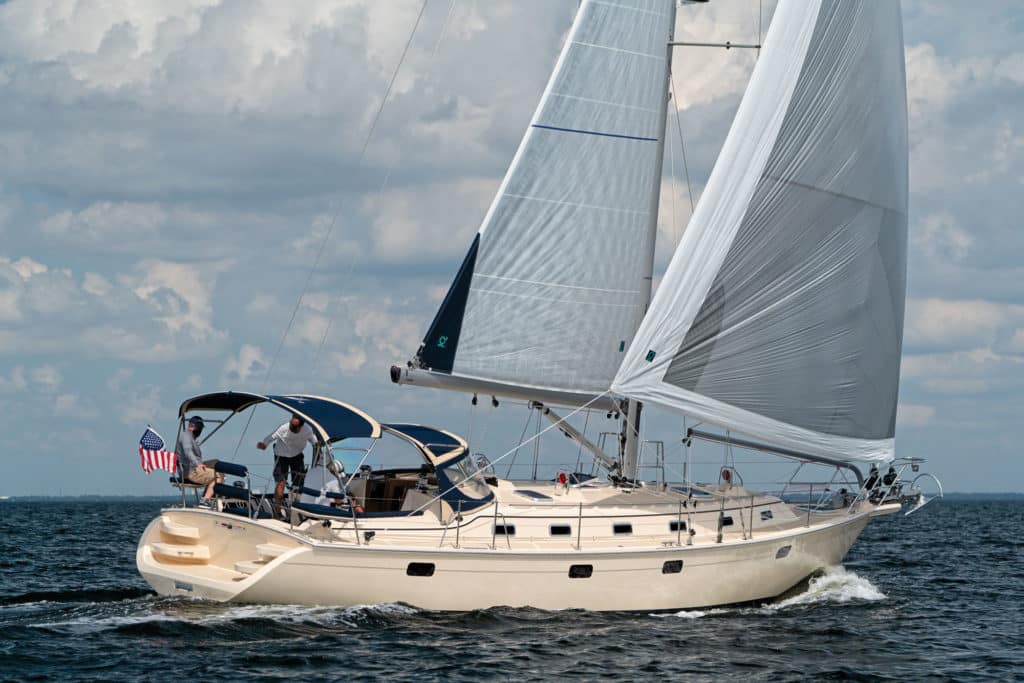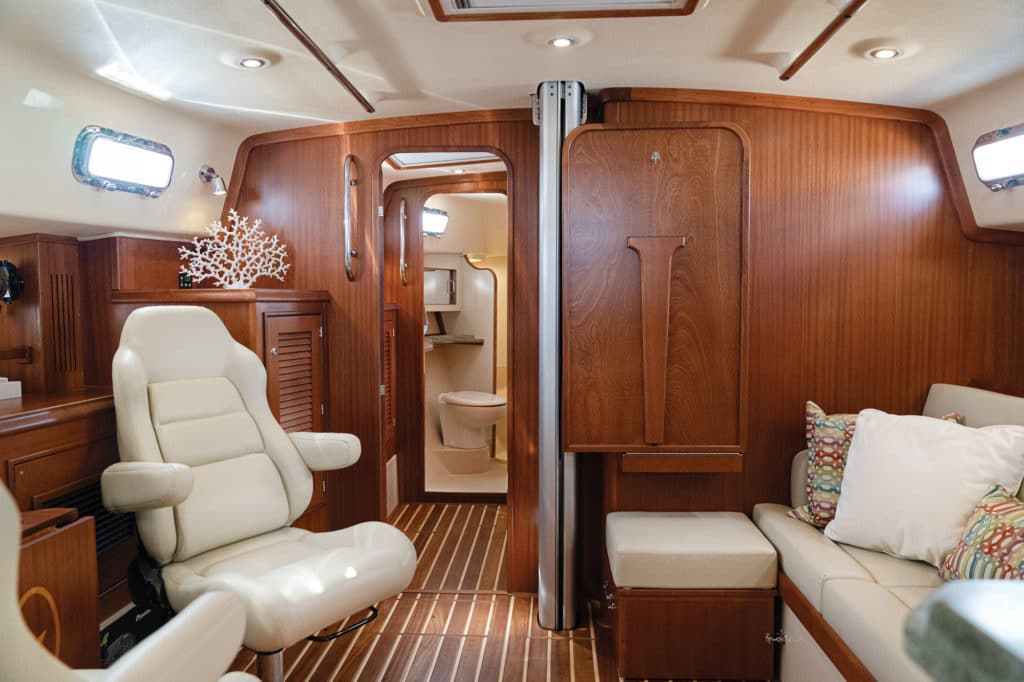
When Island Packet Yachts launched some 40 years ago, skippers in yacht clubs and bars from here to Oz still heatedly debated whether boats equipped with fin keels and spade rudders were safe to sail out of sight of land. And so, between the wrangling over newfangled foils—and design trends favoring plummeting displacement/length ratios—it’s no wonder that company founder and naval architect Bob Johnson struck a chord with his liveaboard cruising sailboats that featured stout ivory-colored hulls, patented Full Foil Keels, skeg-hung rudders, and manageable cutter rigs. In the decades since, in fact, it’s those very elements that, when combined, created the iconic “IP look” that’s still available and in demand today from the Largo, Florida, yard.
The company, though, is now owned and operated by former longtime West Coast IP dealers Leslie and Darrell Allen, who last fall introduced their second new model, the IP 439, which Cruising World’s Boat of the Year judges named Best Full-Size Cruiser for 2021. That award came just two years after their first new design, the IP 349, was named overall Boat of the Year for 2019.
Against competition that included boats built to much more modern and trendy designs, both these Island Packets stood out for their sailing performance. And it’s no accident that both sported so-called solent rigs that pair a self-tacking jib on an inner forestay with a 170 percent genoa on a second stay just forward of it. In moderate and heavier breeze, the self-tacker takes the work out of upwind sailing, and cracked off a bit, or in very light conditions, the big genny has all the horsepower needed to give the boat some get-up-and-go.
And off we went. Sailing on Tampa Bay in 5 to 8 knots of breeze this past October, the 439′s speedo hovered in the mid-6- to low-7-knot range—not bad for a boat with a displacement-to-length ratio of 259, by far the highest of all the boats we tested.
A choice of sail plans is just one of the options the Allens are willing to entertain now that they’re running the company. Their challenge: to keep what works but incorporate ideas from customers and even the team on the shop floor that will make the designs better and keep them evolving. For instance, at the request of customers, IP will now build boats with or without a Hoyt jib boom for the self-tacking jib. One customer asked for a safe, and now a lockbox is a standard option. They even have a couple of boats under construction with blue hulls and white decks rather than the trademark ivory!
But don’t get me wrong—compared with what’s out there, the 439 is still very traditional, some might even say conservative. It sports a sugar-scoop stern rather than a drop-down transom, a single wheel and rudder, hand-laid solid fiberglass hull, and lead ballast that’s encapsulated in the full keel and then covered with concrete and resin.
Gone, though, is the marine plywood used in interior construction. It drove the Allens crazy as dealers. Water would seep under sinks and counters and rot the underlayer, or customers would return from the tropics, where termites literally ate and destroyed the plywood used in structural areas. Instead, the yard now uses Coosa Board, a composite material that’s indestructible. The intent, Darrell says, is to use the best material they can find and look for improvements without straying too far from what’s made the brand successful.
The 439, for instance, uses the same Bob Johnson-designed hull as did the older 440 and 460 models. The interior, aforementioned sail plan and transom have all been revised, though, and all exterior wood has been eliminated to cut down on maintenance.
Down below, the nav station was sacrificed to free up space for a larger galley with room for a stove, an oven and a microwave; Corian counters with deep fiddles; and abundant fridge, freezer and storage space.

Aft of the galley, in place of a starboard cabin, there’s an interesting little utility room that on the boat we sailed included a vented washer and dryer, additional freezer, storage space, a 6 kW Northern Lights generator (complete with a little stool for working on it), and filters for the genset and 80 hp Yanmar diesel with shaft drive, located in the adjacent engine compartment.
The port aft cabin is cozy, with a double berth and hanging locker, and access to the guest head and shower. And the saloon is laid out similar to a small living room. To port, a pair of captain’s chairs flank a drop-down table. To starboard, there’s an L-shaped settee that can double as a sea berth, and a bulkhead-mounted table that folds down for dining and reveals a nifty cabinet with movable shelves and dividers that can be adjusted to accommodate various-size bottles and glasses.
The owners’ cabin is forward to starboard, with a diagonally oriented queen berth and his-and-her hanging lockers. In the head off to port, I thought the glass shower door with waves etched into it was a nice touch.
Base price for the 439 is $470,000 and change. But the boat we sailed was loaded with options and carried a price tag of $670,400. Among the bells and whistles: watermaker, four additional house batteries, three solar panels incorporated into the Bimini arch and davits, underwater lights, a four-blade Max Prop, 12-volt air conditioning in the forward cabin, bow thruster and absolutely stunning Quantum Fusion Membrane sails.
Oh, speaking of sails, the 439 also sports the new Synchronized Main Furling system from Seldén, which lets you set the main while standing at the helm with the touch of a button. (For more on the system, see “Smart Winch, Smart Furler,” page 46.)
This being Hull No. 1, there were a few things to tweak. Under sail, I found it a little tough to read the jib telltales, and a plastic cover over the control switches for the electric jib-furlers made it hard to reach them when furling the genoa to tack. But things like that are easy to fix. Over all, there was a tremendous amount to like about the 439, including the Allens’ willingness to, say, rearrange the saloon, add a nav station, or replace the utility room with a third cabin. The list goes on and on.
Unfortunately, our sail didn’t. The 439 is a big rangy boat that makes you want to live aboard, go sailing, entertain friends in warm places. We, the Boat of the Year team, couldn’t, of course. We needed to get back to work and give it a big award.
Island Packet 439 Specifications
LENGTH OVERALL: 45′9″ (13.94 m)
WATERLINE LENGTH: 38′1″ (11.61 m)
BEAM: 14′4″ (4.37 m)
DRAFT: 5′ (1.52 m)
SAIL AREA (100%): 1,131 sq. ft. (105.1 sq. m)
BALLAST: 12,000 lb. (5,443 kg)
DISPLACEMENT: 32,000 lb. (14,515 kg)
BALLAST/DISPLACEMENT: 0.38
DISPLACEMENT/LENGTH: 259
SAIL AREA/DISPLACEMENT: 18
WATER: 260 gal. (984 L)
FUEL: 160 gal. (606 L)
HOLDING: 55 gal. (208 L)
MAST HEIGHT: 62′5″ (19.03 m)
ENGINE: 80 hp Yanmar
DESIGNER: Bob Johnson/Island Packet Design Team
PRICE: $670,400
Sea Trial
WIND SPEED: 5 to 8 knots
SEA STATE: Calm
SAILING: Closehauled 3.7 knots/Reaching 7.2 knots
MOTORING: Cruise (2,000 rpm) 6.2 knots/Fast (2,600 rpm) 7.6 knots








